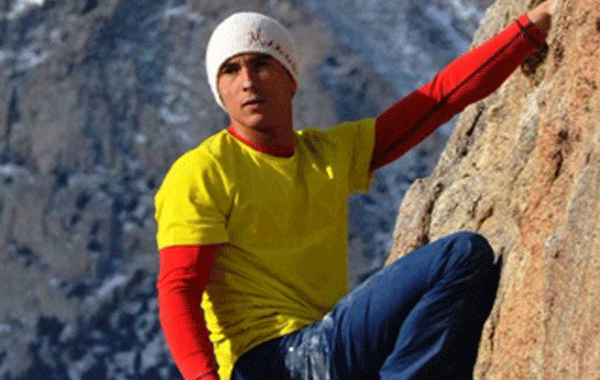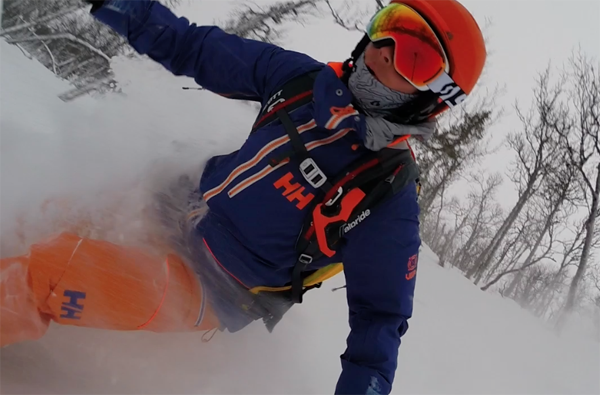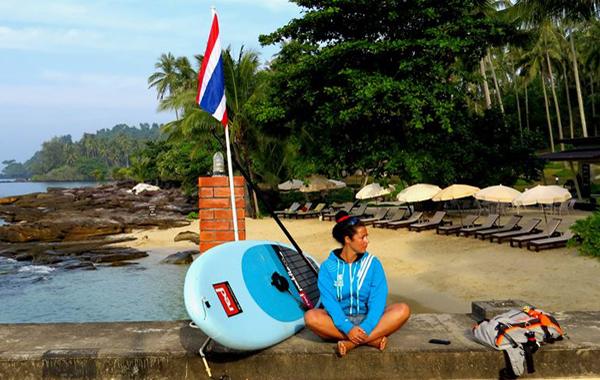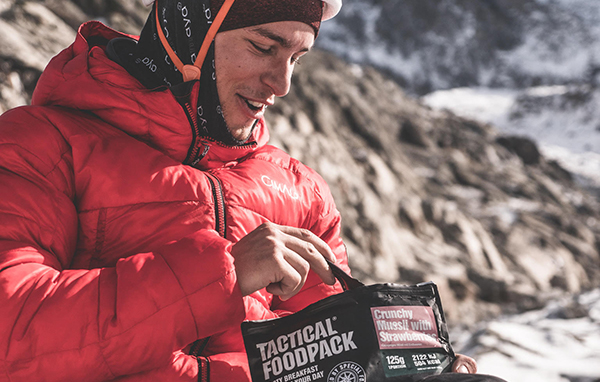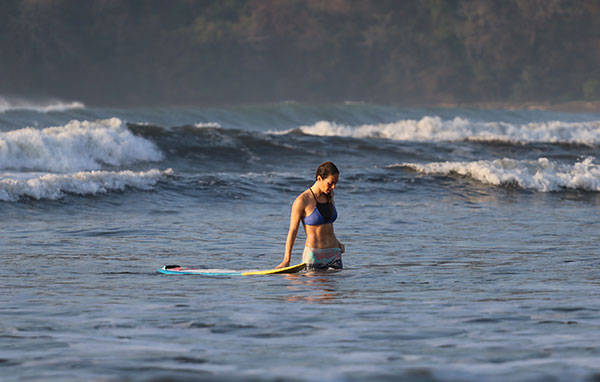WHILE WE’RE committed to bringing you interviews with some of the greatest living extreme sports and endurance athletes, as well as insight into some of the toughest adventure and sporting challenges taking place in the world today, sometimes it’s important to stop and explore new ambitions in the world of sport.
Step forward then Enrique Cubillo who is the creator of spikeboarding and is intent to see the sport grow to the full potential he believes it has. The sport involves a board with wheels and a spike and although in its infancy has seen interest from high profile skiier Matt Liebsch.
Rather than try to explain more we’ve left that to Enrique whose passion and dedication to spikeboarding sees no limit.
You can also find out more about spikeboarding at www.spikeboarding.com.
Could you tell us where you idea for spikeboarding came from and what it’s all about?
I had raced bikes for many years beginning the age of 30. Of course this means winter training in January and February. These are very, very cold months in New York City. I had achieved all that I needed on the bike and I turned to running with an eye on triathlon. The running injuries devastated me. It was one after the next and I was told this was the way of the running sport.
Working as a photographer this was unacceptable. I needed to walk for a living! Running made this impossible.
As a youth and to this day I can do a handstand on a skateboard. The cycling had also devastated my upper body, after 15 years I was a half a developed man. Massive legs with no upper body development. Somehow I thought, well if I dedicate myself to kicking a skateboard to Central Park in the afternoons in summer and then I do hand stands down some low rolling hills, that will be fun and it will develop my upper body. I tried that for a few days and by chance I saw some Nordic roller skiers in the park. Suddenly I thought, why not use the carbide steel spike tip that Nordic roller skiers had been using for the last 40 years in World Cup racing and apply it to the skateboard!
I made the first crude skateboard spike and I began to SUS (stand up spike). This was the first stroke to be innovated. The feet never touch the ground and you spike on a 45 degree angle exactly like a skier will in double poling and it only happens on the front side. Arms are way chocked up at the top of that shaft. Very different than the super low performing ‘land paddling’ that had been going on with a rubber footing previously. I was very weak! I could not go up a two foot lump! I had no upper body power at all, I had zero core and zero back! Slowly however I began to go up larger and larger elevations. In a few weeks I was going around the Central Park loop, 6.3 miles of low rolling hills, and I made it all the way around once! I was ecstatic and the upper body development was working well.
I had no intention of creating a sport, I was just happy to be engaging the core and back and developing. It bothered me however that I was not using my legs.
On August 10 of that same year (2010) I realised that I could kick with one hand and spike with one hand at the same time! I called this stroke CXC or cubi-x-cross. Once the CXC stroke was innovated I knew that spikeboarding was born and that it could be a global race sport. I have never stopped practising the sport ever since.
It is so convenient for the entire body and I can do it right from my front door.
Spikeboarding is the sister sport to Nordic skiing, as simple as that. It delivers all the same things that the Nordic roller ski does, only it’s a little more casual and less complicated. Think for instance snowboard to ski.
Spikeboarding is the last overlooked sector left to innovate for the board and four wheels. It is the only sport born on top of a device that has lived exclusively in the daredevil theatre for its entire existence and now travels to the endurance theatre. No device has ever made this directional leap. The bike, skate and ski all begin as endurance before slowly making their way towards daredevil and acrobatics. Imagine for a moment that road bikes did not exist, there was no velodrome racing at all and that bicycles were only 20 inch wheels with tiny frames and all people did on them were tricks and flips and perhaps there were a few bigger size off road bikes that people bombed down hills with. Imagine all that and then you can understand the significance of spikeboarding as an innovation happening of course because the carbide ferrule spike tip has to ultimately meet and join in with the board and four wheels by way of two new human propulsion strokes called the sport of spikeboarding – the sport of balanced strength.
What is the difference between spikeboarding and stand up spike?
Spikeboarding is a combination of two strokes, SUS being one of them, the other is CXC or cubi-x-cross. SUS can stand alone as a race stroke and sport. Many people may only desire to learn SUS or they may become specialist in SUS only. There will be SUS only races. Very simple. Spikeboarding is two strokes. SUS is dedication to only one.
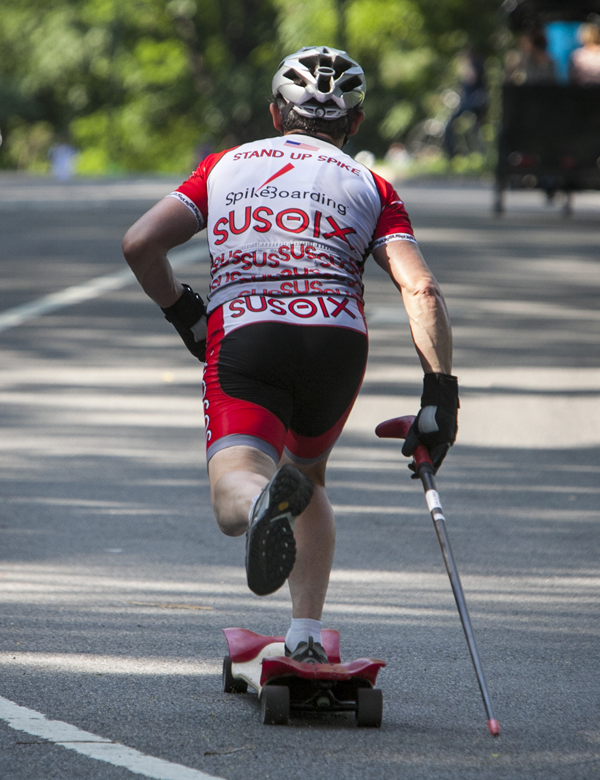
©85Photo
Could you tell us about your head-to-head with Matt Liebsch and what the outcome was?
Certainly. The idea was never so much to ‘race’ but rather to ‘exhibit’ both SUS and DP (double pole) and see how they stacked up when they were challenged to climb nine-and-a-half miles and 2,200 feet of elevation. I have to admit that I had never seen DP climb terrain of this kind so I was delightfully surprised when I saw Matt’s amazing performance. For starters, I have been around for quite some time in endurance races and climbing hills really is quite the solitary experience no matter who you are pitted against. The mountain is there and your motor has a limit, climb over that limit and bang, you will explode. So there is never really all the nervous energy that other events have at the start, you sort of know, well we will hit the climb and do all we can but governing your own speed to not explode is so critical.
That said, I knew I’d have a terrible or at least not optimal warm up and so it was. So right as it got vertical right there at the start the full force of the ‘terrible warm up feeling’ hit this 50-year-old hard and fast and took a massive bite into my glutes of all places! Really everything was telling me to stop, but naturally with experience you simply repeat over and over, “I’ll feel better in 30 minutes” and yes I did begin to feel better… after 40 minutes!
Initially once the 200m opened up between us it stayed the same sized gap up until we hit the Mill Valley Inn, about 30 minutes in. He was in sight up until then. Right there in front of the MV Inn was also a dangerous descent for Matt since he can’t brake and we made that a neutral section for both of us. Just after that section is a sort of long 1.3-mile false twisting flat and I knew that in that section he’d be off and gone. Mostly because he is one of the best in the world on that kind of terrain and also because of the other mitigating factors like the weight of the non-optimised SUS gear I was on, my age and also the rolling resistance of the wheels I had and also perhaps, we still do not know, the physical dynamics of DP stroke over SUS stroke as a propulsion stroke. We really will never know until we match perfectly all these variables and hence we had an ‘exhibition’ more than a race. But I did drop ten minutes off my previous SUS KOM time only 50 days prior. I did arrive 13 lbs lighter along with a little training block that got tossed in.
As you can see in the video Matt never lets up and destroyed the course up to the end. The mark of a solid athlete as well as one who really knows how to climb. It will be really fun to see how long that time lasts. All in all it was a fantastic time and of course for the history of SUS, it’s just an honour to exhibit next to the wonderful sister sport of Nordic ski with such a talented athlete.
Sure I remain the SUS KOM, but really I am just a stand in waiting for the real King to arrive. Men with gray hair are never fast! It would be silly for me to think I was anything but the first example of what SUS can do on a big mountain. If I posted 1:27, 28-year-olds on light gear may get close to 1:09.
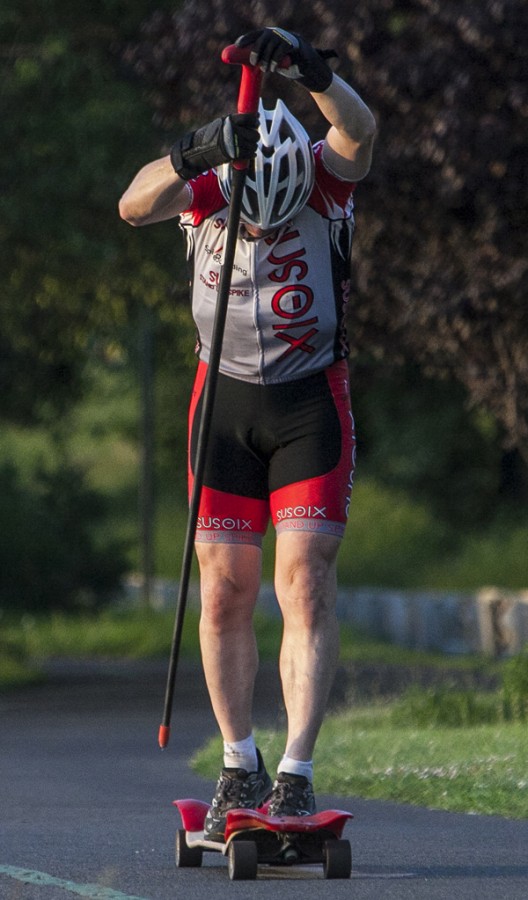
©85Photo
What is the next challenge you’ve set yourself and how will you go about achieving it?
There are personal challenges and also the challenges facing my company SUSOIX (sun-soy, a double acronym meaning stand up spike and OIX being the three race symbols indicating O for downhill I for SUS and X for CXC stroke, these will be all over the race course strategically challenging spikeboard racing) which is rolling out two sports and events. After five years of spikeboarding development the skill set is firmly in my quiver of language movements. So now I am expert in cycling, SUP and spikeboarding. Also I banked three years of short track on ice.
The only one that remains to conquer and toss into the line-up is Nordic ski and that of course is so well connected to SkiMo or ski mountaineering (using skins on the bottoms of your skis, scaling the ascent and skiing back down) something I am dying to begin. Nordic ski for me will require a ton of Nordic roller ski and of course with five years of spikeboarding I have a tremendous base and motor to begin. Nordic roller ski is very challenging but it must be done if you want to ski on snow well and you live a great distance away from snow. So now everyday after the Stand Up Tam event I’ve been on Nordic roller skis. Without my spikeboarding base I think I’d never have been able to chew it off. Nordic roller ski is just so demanding and to arrive with a weak upper body and be asked to also have tremendous technical balance skill set, well I suppose I could have done it but I’m so happy I had spikeboarding first. SpikeBoarding is really just a sort of casual newbie way to acquire a massive Nordic upper body motor. Best part about it is that you can commute with it, something next to impossible with Nordic roller skiing in NYC where I live.
The challenges that face SUSOIX, my company, now as we continue the roll out of the sports is letting the outside industry see how equal to mountain biking the innovation of spikeboarding is and taking on strategic partners that get it. This is something I think the Stand Up Tam exhibition has done. I know certainly Matt Liebsch’s eyes have been opened to the possibilities of getting youth and everyone for that matter in Miami/LA/Atlanta/Chicago/NYC etc, all areas where Nordic movements are not so fully understood, to begin to understand the sport and see Nordic skiing as something to not only aspire to but really begin to see a way to get there.
It’s funny when you tell local people that you did SUS up Mt Tamalpias, they are simply either dumbfounded or in disbelief. Of course for Nordic skiers this is commonplace for the elite and naturally for elite road cyclists Tamalpias is small as far as climbs go. But the upper body is just not understood, this massive section of trunk and limbs can motor more then any one can imagine.
So SUSOIX is just marching along humming the tune of Nordic movement and telling the world to get involved in sport and transport sport movement languages, there by making the planet proud as we sport and commute, the ultimate message, becoming the motor and living by using all the transport sports recreationally and as local transport.
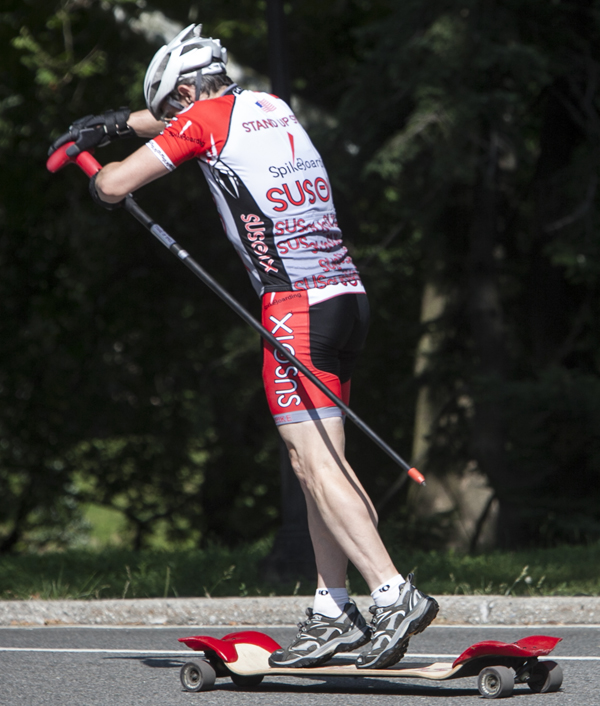
©85Photo
To what extent has spikeboarding caught on?
We are just over a dozen worldwide now. Last year there were none.
How do you intend to make it grow quickly?
Spreading the message of lifelong full body fitness and teaching people the simple concept of leaning transport sports to use as sport and transport is how SUSOIX will continue on with all that we do. Become the motor. It’s that simple.
Spikeboarding just happens to be a very handy movement language to speak. Honestly it provides just about every aspect of fitness, minus flexibility, and you can commute with it. Strength-endurance-balance and all that from your front door and in street clothes and shoes if you so choose! Once people see this they really begin to enjoy it. It is very fun.
SUSOIX just needs to buckle down and get the disc brake out so folks won’t have to be so conscious about terrain selection and where they go. But honestly some locations are so perfect right now because they have very low elevations. For instance St.Louis, Mo. where I grew up, has three spikeboarders now and they enjoy perfect conditions everywhere in that town, no hill will pitch you past 30mph! I love to spikeboard in STL! Incredible glassy roads with very low traffic.
As far as targets, it’s not really a shooting gallery situation. SUSOIX will just keep doing what it is doing which is to demo the sport and it will keep growing exponentially. For spikeboarding to have no growth one would have to assume that the ferrule spike tip Nordic skiers use by the millions of people worldwide would be the only place it would be used. The board and four wheels is only a board with wheels on each end. I have no real idea of the future, only that SUS is insanely effective at delivering core out your door and CXC stroke gets you up hills like mad and that at age 50 I have become a brick coal factory and I did it all via spikeboarding and it was a sensational blast doing it.
I also have a little project now of wanting to SUS up the tallest paved roads on seven states. I have New Jersey done. When I do all seven I’ll go back and double pole all of them on roller skis. Nordic movement is just so addictive!
How exciting does it feel to be the creator of this sport and how passionate are you about showing it to the world?
Honestly this question is not so exciting to me. More exciting is what the sport has the capacity to do. I believe the sport has the capacity to grow and become a passionately followed race sport on par with NASCAR over the next 50 years time. Don’t forget that kids born today may never drive and also keep in mind that all motor sport speeds have been governed down slower after the deaths of sensational drivers during the golden era of car racing as speeds superseded the human body’s capacities.
Spikeboarding is born in USA and it develops well the upper body. The public loves to see crashes but not deaths. So the sport as a spectator sport has all the qualities of NASCAR and delivers a Tarzan and Jane build into an era that has become totally schooled on endurance and multi sport and desires ripped abs and strong core. So I am most excited of having a sport that might help a generation of Americans to really begin to want to understand calorie in calorie out and the principles of becoming the motor as a lifestyle.
Regarding innovators in the past, it is fun to know that no single person ever innovated a human race sport. That is both fun and also a curious occurrence, but I think of it more outside of me personally and more as a fact of history. Honestly it is making it a bit harder for the sport to grow but look, facts roll out as they do and we just live with them. I keep spiking hard and spiking often and that makes me very happy and insanely fit.
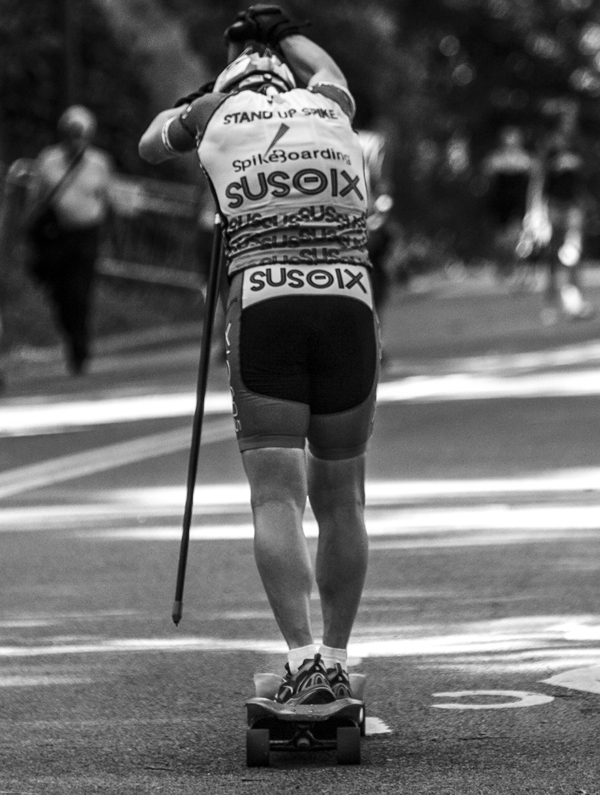
©85Photo




